![]()
 | 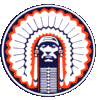 |
![]()
[Link to All-Time Series Results]
The series between Kentucky and Illinois (currently led by Kentucky 11-4) is a relatively short one, but has involved many important and highly competitive games. The two schools tended to play games in spurts, followed by many years of never seeing each other, despite being bordering states. The two schools also share a common legacy, dating back to the early times of basketball as a major sport.
![]()
Game by Game Review
The first game between the two schools was held in January of 1925 when the Wildcats travelled to Champaign-Urbana to face the Illini under Coach Craig Ruby. Kentucky was led by a fellow Illinois alum, Clarence Applegran.
Despite students just arriving on campus to resume their studies, the gym was filled to capacity to see the game. The game was held in the Kenney Gymnasium, which originally was built in 1902 and served as the school's primary basketball gymnasium until the end of the 1925 season.
The visiting Kentuckians jumped out to an 8-2 advantage before Illinois steadied itself. Key in the Kentucky attack was the short pass and a driving offense. By the half, the Wildcats held a 17-15 lead.
After the half, the two sides each hit a free-throw, before Illinois captain John Mauer hit a shot from the field to tie the game 18-18. The two teams continued to fight and saw the score tied a total of seven times, before the Illini finally gained control with their superior shooting and defensive play which limited the Kentuckians shots at the goal in the second half. In the final minute, Coach Ruby brought in his reserves. The final score was 36-26. Leading the way for the Illini were Russell Daugherity, Leonard Haines and Hollie Martin with eight points apiece. James McFarland paced the Wildcats with 10 points.
 |
[Boxscore] - 1924-25
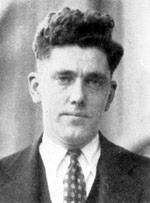 |
Mauer was an all-around athlete at Illinois where he played in the same backfield as the legendary Red Grange. He also was captain of the basketball squad and as a senior, was awarded the Big Ten's annual trophy for all-around athletic and academic excellence.
At Kentucky, the newly graduated Mauer introduced the "Illinois system", sometimes known as the "submarine attack" which consisted of short bounce passes designed to probe and attack the opponent's defense. The system was slow and took some time for the players to learn, but was effective if used properly, and the Wildcats were largely successful against their Southern competition, which was not accustomed to defending the system. The Wildcats went a combined 40-14 over a three-year period under Mauer. They reached the semi-finals of the Southern Conference tournament twice during those years but were never able to claim the top prize under Mauer. Eventually, Mauer left the school over a salary dispute. This created an opening which would be filled by Adolph F. Rupp, a hiring which would alter the fortunes of Kentucky basketball forever.
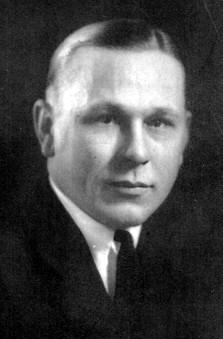 |
Kentucky, as part of their job search, had contacted Ruby (perhaps to offer the position to the Illini mentor) but ended up asking Ruby for his opinion and suggestions possible candidates. Rupp was one of the names recommended by Ruby, along with a recent Illinois graduate, Doug Mills. Rupp was later contacted by Kentucky and interviewed for the job. When asked why he should be chosen as coach, Rupp reportedly replied "because I'm the best damn coach in the country."
In the end, Rupp was offered the position, however he had reservations about accepting the offer. The job offered a salary of $2,800, not any more than his current position at Freeport, and he found the program lacking. After a disappointing first impressions of Lexington, Rupp noted to Russell Rice: "Finally I was taken to Alumni Gym. I saw this little old peanut-huller of a gym, and I just couldn't get steamed up,". Rupp sought guidance among his Freeport friends, most of whom suggested he stay in Freeport. However, one confidante gave him opposite advice. Rupp was reportedly told that if he stayed coaching high school he may never receive another college coaching offer, however if he gains college coaching experience, even if he fails, he could still have any high school position he wanted. This is the advice Rupp ended up taking.
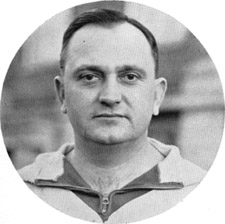 |
The next meeting between the two schools occurred in the East Regional of the NCAA Tournament in 1942. At the time, the field consisted of only eight teams, with the invited teams largely chosen by region. Kentucky represented District 3 (Southeastern states) while Illinois represented District 4 (Illinois, Ohio, Indiana, Michigan, Wisconsin and Minnesota). Other teams in the regional were Dartmouth representing District 1 (New England states) and Penn State representing District 2 (New York, New Jersey, Pennsylvania, Delaware and West Virginia). With only an eight team field, the champion only needed to win three games. The first two rounds of the Eastern half of the country were held in New Orleans with the championship game held in New York City's Madison Square Garden.
The site of the game was Fogelman Arena on the Tulane campus in New Orleans, as the larger Municipal Auditorium was being used by the Armed Services as part of the war effort. This was both program's first appearance in the tournament. Kentucky had been invited in previous years but refused the invitation from the fledgling tournament, citing travel and loss of classroom time concerns.
During that time, there was a nearly three-week lag between the end of the conference tournaments and the start of the NCAA's. Before the teams even received bids to the tournament, there was talk of the Wildcats and the Big Ten champion Illini holding a charity game in Louisville to support the Naval Relief Fund. This match between the two fell through, but the Wildcats did end up facing the Great Lakes Naval Air Station on February 14th.
Prior to the contest, Illini coach Doug Mills chose to house his team apart from the other three teams in New Orleans. This reportedly irked the Wildcats and this provided even more incentive for a victory. Kentucky did win the game, 46-44, as Milt Ticco paced the Wildcats with 13 points. Ken Mehnke paced the Illini with 15 points while Arthur Smiley contributed 13.
The game was tight throughout, with no team leading by more than six points at any time. Near the end of the first half, Illinois led 22-18 but Marvin Akers launched a long shot before the gun sounded which brought the Wildcats within two points at halftime. After that, Akers, Ticco and Carl Staker led the charge coming out of the halftime locker-room which resulted in Kentucky taking the lead on a "brilliant" Jim King field goal.
As the regulation period came to a close, the Illini made a furious comeback which saw Jack Smiley hit a shot to close the gap to two points, 46-44. Illinois had the ball and were driving toward their goal when the game ended.
[Boxscore] - 1941-42 - NCAA Tournament
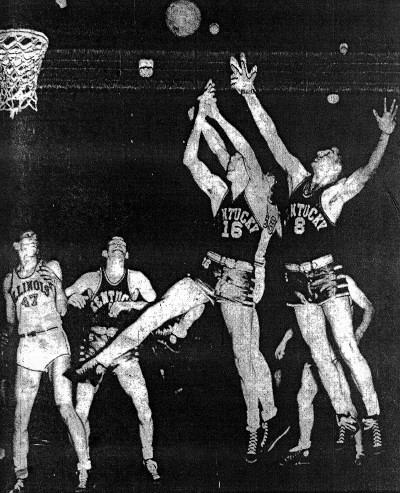 |
A few weeks earlier Kentucky coach Rupp had stated that a first-round matchup with Illinois would ensure that the second-round opponent would be an easier challenge. But this did not prove to be the case, as Kentucky went on to lose the following night to Dartmouth, who went on to lose the following NCAA title game in New York City.
This loss proved to be a missed opportunity for the Illinois team which would soon become known as the "Whiz Kids". The following year (1942-43) the Illini team went 17-1 and a perfect 12-0 in the Big Ten, but chose to turn down a NCAA bid, citing concerns over lost time in the classroom. Soon thereafter, the squad was broken up as the starting five entered the armed forces as part of the war effort.
 |
Two year later the two teams met in the regular season for a two-game series. In the spring of 1942, the country was committed to the war against Germany and Japan, but by 1943-44, the full effect had hit collegiate basketball. Many schools temporarily gave up the sport, while those that retained teams (and weren't lucky enough to have a training base located on their campus) did so with freshman and sophomores who could be called to duty at any time, 4Fs and others. To illustrate the terrible toll, of the Kentucky players who participated in the game in 1942, most wound up in the Armed Services, while three of them, Melvin Brewer, James King and Kenneth England all ended up sacrificing their lives in the struggle.
Kentucky that year was led by Kansas freshman center Bob Brannum. The rest of the team consisted of two sophomores and the remainder freshmen and were referred to as "The Beardless Wonders". Illinois was also extremely young, as the entire "Whiz Kids" team had entered the military after the previous season, and were replaced by primarily freshmen.
The first game between the two was held in Urbana at Illinois' Huff Gymnasium. Just getting to the game was an ordeal. With the war in full effect and troop movements happening all over the country, the teams had to deal with travel restrictions and had to use what was available. For the trip to Illinois, Kentucky was scheduled to catch a train leaving Lexington at 3 a.m. When no train arrived, the squad caught some rest but continued to report to the station every hour on the hour until 7 a.m. At that point, after no train was apparent, Rupp chose to take a bus To Champaign.
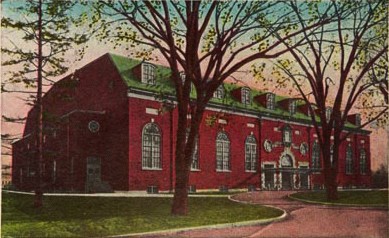 |
Kentucky was undefeated at the time. Illinois had lost only one game, to the Great Lakes Naval Air Station, the military juggernaut which boasted many former collegiate All-Americans on its roster.
Kentucky jumped in front at the start of the game, based largely on the outside shooting of Walter Johnson and Tom Moseley along with the inside work of center Bob Brannum. Illinois scored only three field goals in the first 14 minutes, all by Howard Judson, as the Wildcats built a large margin, which was whittled down to four, 28-24 by halftime.
In the second half, Kentucky still led most of the way but the Illini clawed back in the closing minutes until the closing minutes. Illinois guard Dick Foley scored on a put-back basket to put his team in the lead 40-39 with three minutes remaining and later added a free throw to give the Illini a two-point margin. Kentucky freshman Rudy Yessin then responded with a 20-foot hook shot which knotted the score, 41-41.
This set the stage for Illini forward Howard Judson, who tossed in a basket with 40 seconds left to put Illinois ahead, 43-41. Kentucky had three desperate shots at the goal but couldn't connect, and finally Judson grabbed the rebound just before time expired to secure the victory.
Howard Judson finished with 15 points to lead the Illini, a scoring total matched by Brannum of Kentucky.
[Boxscore] - 1943-44
The return game saw Kentucky gain a measure of revenge by defeating the Illini 51-40, but the victory didn't come as easily as the margin suggested, as the Illini held a 25-21 halftime lead, and the score was tied five times before the Wildcats made a late push to run away with the victory.
As in the first game, Kentucky All-American Bob Brannum controlled the inside and this allowed Kentucky to jump out in front, 19-8, before the Illini mounted their own scoring spree of 17-2, relying on forwards Stan Patrick and Howard Judson to finish the first half.
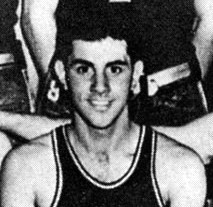 |
The victory gave Kentucky a 12-1 record, with their only blemish being the earlier loss to the Illini. Illinois' record stood at 7-6. Kentucky coach Adolph Rupp said at the end of the game that he was, "tremendously proud of the boys tonight. They played a truly great team and had to be good to win. They played the game exactly as we planned it." Rupp also praised the Illinois players saying "In Patrick and Judson they have two of the best big men who have ever played in Lexington."
[Boxscore] - 1943-44
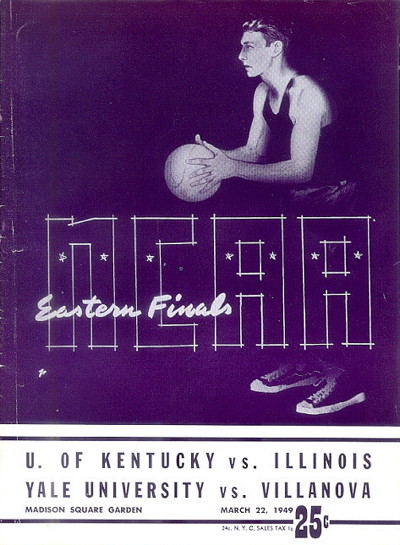 |
Harry Combes was the coach of the Illini. Originally from Monticello, IL, Combes graduated from Illinois in 1937 and then became a successful high school coach at Champaign Central High School, before taking the head coaching position at Illinois in 1947.
The Wildcats had won the NCAA championship the year previously, and were heavy favorites to repeat, given that most of their players, including three All-Americans returned. The crowd of 15,126 at the Garden were heavily supportive of the underdog Illini.
Despite the crowd support, the Kentuckian took control of the game early on and never allowed the Illini or their own All-Americans in Dwight "Dike" Eddleman and Bill Erickson to get into the flow of the game. Kentucky All-American center Alex Groza led the Wildcats with 27 points. As noted by wire reporter Stan Optowsky, however, "This was no one-man show. In addition to Groza, there was gum-chomping Ralph Beard driving in for layups, fancy-flipping Jim Line with a left-handed shot that wouldn't miss and the cool floor mastery of Cliff Barker. They all added up to a sweeping victory."
Illinois shows signs of competitiveness early in each half but could never mount a coherent attack against the well-oiled Kentucky machine. With approximately five minutes remaining, the Illini began shooting desperation shots and this only served to allow Kentucky to open up the lead further.
After the game, Kentucky left the court to the strains of "Auld Lang Syne," as this was the last game the group would play collegiately in a Madison Square Garden arena which had been the scene of so many important battles and victories (including an NIT and NCAA Championship, along with a championship final for the 1948 US Olympic team.)
Rupp announced that Kentucky and Illinois would leave New York by a special airplane the following morning bound for Seattle, site of the NCAA championship and consolation game. The Wildcats ended up winning the championship, 46-36 over Oklahoma A&M. Meanwhile the Illini beat Oregon State 57-53, to secure 3rd place in the national tournament.
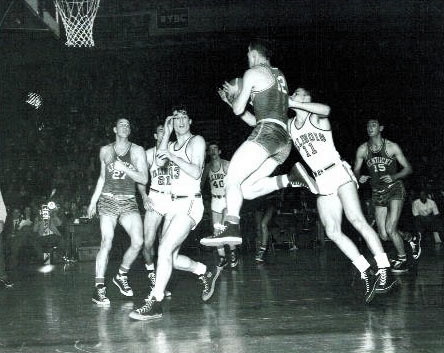 |
 |
[Boxscore] - 1948-49 - NCAA Tournament
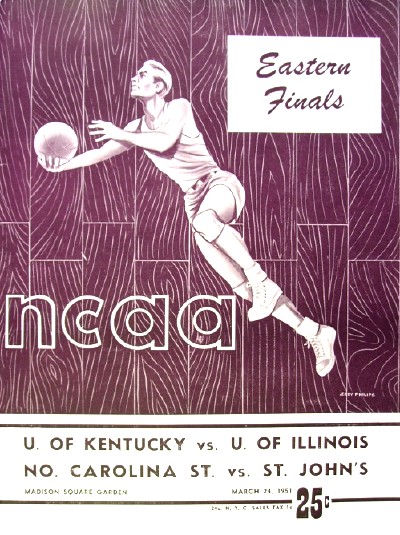 |
Shelby Linville scored the winning goal with 17-seconds remaining on the clock. The Illini called time out with 12-seconds left to set up a final play. With the clock winding down, Illini guard Don Sunderlage, who had scored 20 points in the game, penetrated the Kentucky defense and shot a 10-foot hook shot which fell short, bouncing off the rim to the floor. As the two teams scrambled for the rebound, the final buzzer sounded.
The first half of the game was all Illinois as the boys from Champaign-Urbana controlled the boards, despite the presence of seven-foot Kentuckian All-American Bill Spivey. While Kentucky was missing close shots, the Illini were doing a good job boxing out the Kentuckians and securing the ball. At halftime, the Illini held a 39-32 lead.
 |
Spivey fouled out with a little less than three minutes remaining in the game after Illinois' Rod Fletcher drove into the lane and was fouled by the tall "Georgia Pine" to send Spivey to the bench with five fouls. Minutes earlier, Fletcher had driven the lane and converted a field goal and free throw on Spivey's fourth foul to cut the margin to 70-69. This time, Fletcher missed the two free throws, which would have tied or given the Illini the lead.
The loss of Spivey was a blow to the Wildcats, as they had already lost their other All-American player, Cliff Hagan on fouls and would soon lose Lucian "Skippy" Whitaker. Little used C.M. Newton took his place and finished the game.
In Spivey's absence, 6-foot-5 Shelby Linville stepped in and he secured the win. He scored the final three field goals for the Wildcats which kept them in the lead. For the final basket, Frank Ramsey spotted Linville open under the basket and whipped him the ball for an easy score. This set the stage for the Illini's futile last attempt to tie the game.
Bill Spivey led all scorers with 28 points and 16 rebounds. Shelby Linville added 14 points while Bobby Watson and Skippy Whitaker each added 10 to the Wildcat cause. Leading the Illinois attack was Rod Fletcher with 21 points and Don Sunderlage with 20. ??? Peterson added 12 points.
Kentucky went on to face Kansas State the following week? where they won their third NCAA title in four years.
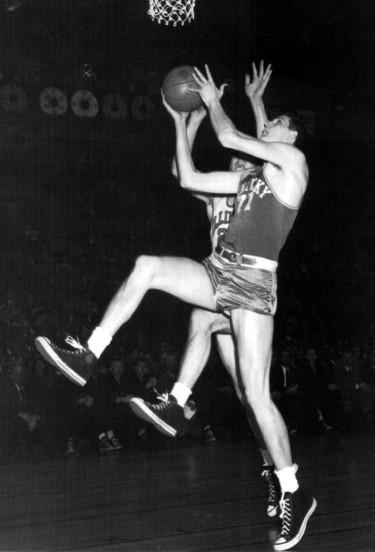 |
[Boxscore] - 1950-51 - NCAA Tournament
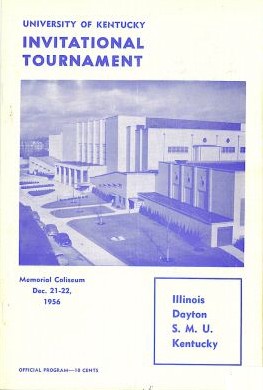 |
In 1956, Kentucky beat Southern Methodist and Illinois dispatched Dayton to set up a match-up in the Championship game the following night.
Harry Combes' Illinois entered the tournament undefeated and highly ranked. The Illini stayed close to the Wildcats the first half, with Kentucky holding a 40-34 advantage at halftime. But five minutes into the second half Kentucky guards Gerry Calvert and Vernon Hatton started to penetrate the Illini defense and Wildcat big man Ed Beck controlled the boards, the Wildcats ran away with the game, winning convincingly 91-70.
Hatton led all scorers with 25 points, followed in the Wildcat's scoring with 18 points for Calvert and 14 points each for Beck and Johnny Cox. Harv Schmidt led the Illini with 18 points and 11 rebounds. Other double-figure scorers were George BonSalle with 13 points and rebounds and Don Ohl with 12 points.
 |
[Boxscore] - 1956-57 - UKIT Championship
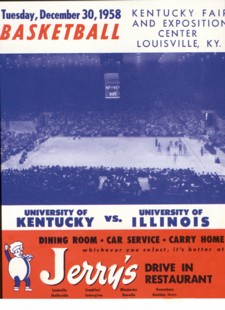 |
The score was tight, with the lead changing hands 11 times over the course of the game. The game was tied at halftime 37-all. Coming out of halftime, the Wildcats committed three straight turnovers and the Illini grabbed the lead 40-37.
Later Wildcat mentor Adolph Rupp called a time-out and moved Bill Lickert to guard and brought Bobby Slusher off the bench at forward and the Wildcats went on a run to take the lead for good. Meanwhile Sid Cohen and Johnny Cox clamped down on Illinois' Mannie Jackson. Jackson had scored 19 points in the first half, but was held to only two more points for the remainder of the game.
The Wildcat lead grew to a ten points, 71-61 with only 4:40 left in the game, but the Illini did not give up. Illinois' John Easterbrook scored two baskets in the closing minutes and Kentucky wilted to the Illini press as they scored the final six points to cut the UK lead to one, 76-75.
As the clock ticked down Illinois secured another steal and Govoner Vaughn shot a 20-footer which would have won the game, but the ball bounced off the rim. Later the referee indicated that the shot had taken place after the horn had sounded. But the shot was dramatic enough that the Louisville Courier-Journal saw fit to publish the photo, showing the flight of the ball as it just missed the mark.
 |
Sid Cohen led the Wildcats with 23 points, followed by Bennie Coffman with 16 and Johnny Cox with 10 points and 14 rebounds. For Illinois, Mannie Jackson led the team with 21 points (again 19 in the first half). Govoner Vaughn contributed 16 points while John Wessels and Al Gosnell each added 11.
[Boxscore] - 1958-59
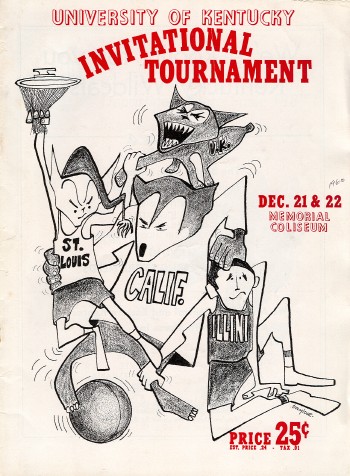 |
Only an estimated 7,000 fans attended game, due to near-zero weather in Lexington, by far smallest crowd to attend a UKIT to that point as typically the games were near capacity.
The Illini took an eight point lead in the first half but by halftime the Wildcats had come back and established a 34-31 halftime lead. The two teams traded leads three times early in the second half, and much like the previous game in 1958, UK established a commanding lead, only to see Illinois fight back and nearly steal the victory.
This time Kentucky took a 13 point lead (69-56) with just over eight minutes remaining in the game. However Illinois fought back to bring the game within striking distance. After Kentucky's Ned Jennings, Bill Lickert and Larry Pursiful had to leave the game on fouls, Illinois made their move late in the game.
This set the stage for a heroic play by UK reserve Jim McDonald late in the game. According to an account by Ed Ashford of the Lexington Herald:
After two free throws by Illinois' Bob Starnes cut the margin back to three points, the Cats were able to freeze the ball until the final seconds and scored a basket as time expired to give them a 83-78 win.
Leading the team for Kentucky was Roger Newman who scored 24 points and grabbed 10 rebounds, followed by Larry Pursiful who added 21 points. Leading the Illini were Dave Downey with 23 points and 10 rebounds and John Wessels with 18 points and 11 rebounds.
Kentucky went on to win the UKIT title over St. Louis the following night while Illinois lost badly to Cal in the consolation game.
 |
[Boxscore] - 1960-61
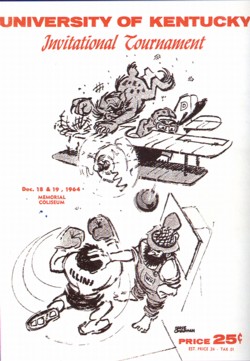 |
The Illini entered the event 4-1 and sky high after beating AP No. 2 ranked and defending National Champion UCLA in Champaign to open the season. The Illini defeated Dayton (104-86) in the opening round of the UKIT and faced AP No. 8 ranked Kentucky in the championship game. For their part, the Wildcats were 3-1 (having lost to No. 13 ranked UNC in Charlotte earlier in the season) and dispatched West Virginia (102-78).
This time the shoe was on the other foot as Kentucky found itself down much of the game and had to make a mad dash to bring the game within reach late in the game. The Wildcats were down by 15 points at one point in the first half and trailed by 9, 48-39 at halftime.
The margin remained through much of the second before the Wildcats made their move. In the final minute Louie Dampier scored two field goals to bring Kentucky within one point, 83-82. But Kentucky chose to foul to get the ball back and Illinois hit their free throws down the stretch, going a perfect 10-10 from the line in the last minute and a half to secure the victory, 91-86. The Illini had only scored one field goal in the last six minutes of the game.
Illinois was led by Skip Thoren with 27 points and 22 rebounds. Tal Brody added 25 points for the victors. Kentucky was led by Dampier's 16 points, followed by Pat Riley and John Adams with 14 apiece.
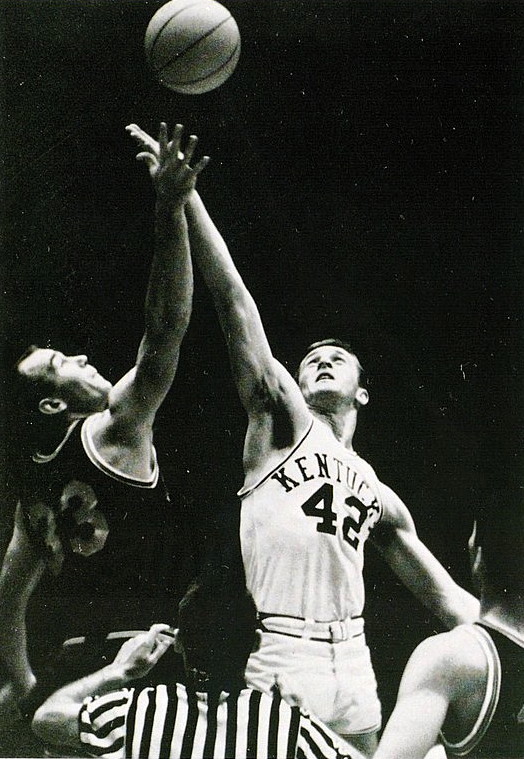 |
With the victory, the Illinois players took home the hardware, which in this case were watches with 10K gold filled bezels. It must have been a surprise, "No one ever won at Kentucky, and especially in the Kentucky Invitational" noted Tal Brody.
This was the first victory by Harry Combes over Rupp in his sixth attempt. "After that game was the happiest I have ever seen Harry...He thought we had accomplished something pretty special and the smile on his face made that pretty clear." noted Bill McKeown.
 |
[Boxscore] - 1964-65
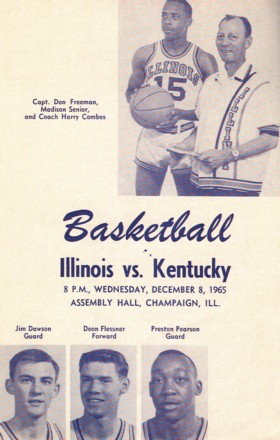 |
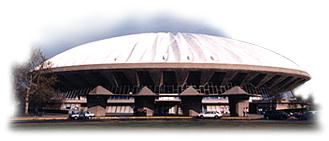 |
Prior to the game, Rupp opened the locker-room to select media members from Lexington to watch a pre-game scouting session, the first time Rupp had ever done this before. While watching a film of the previous year's UKIT game between the two schools, Larry Conley noticed Louie Dampier getting open for a shot and noted: "Coach, Louie worked that shuffle real well. Let's try it tonight."
Coach Rupp took the suggestion and Kentucky employed a weaving offense which picked the Illinois defenders apart. First the Wildcats hit from mid-range and then after the Illini defenders came out to pressure, Kentucky passed the ball inside for easy layups.
Illinois led a few times early in the first half but soon they relinquished the lead and Kentucky never gave it up. The Illini came close a few times, bringing the margin to 4, but the Wildcats pulled away in the end, closing with a 13-2 burst and winning convincingly 86-68.
Thad Jaracz paced Kentucky with 32 points and 12 rebounds, followed by Louie Dampier with 21. Don Freeman, who would go on to set the record for the most points in a season by an Illinois player, led the Illini with 26 points and 11 rebounds, while Jim Dawson contributed 20 points.
Kentucky, already undefeated at the time, went on to win their next 20 straight games. Eventually they made the National Championship game where they lost to Texas Western. Meanwhile, the Illini had a disappointing 12-12 season.
 |
[Boxscore] - 1965-66
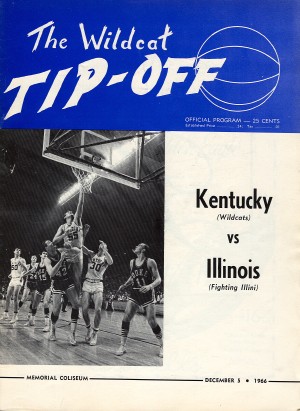 |
Illinois took the lead early and never relinquished it, although Kentucky was able to tie the game seven times, including at the end of regulation to send the game into overtime. Similar to the UKIT game in Lexington two years prior, Illinois built a large advantage, this time 12-points, late in the game and then had to stave off off a furious comeback attempt by the Wildcats.
Kentucky was able to take the game into overtime after Thad Jaracz hit two free throws to tie the score at 85-all, and Illinois' Rich Jones missed a long shot as time expired.
In overtime, Jones scored on a tip-in and Dampier scored before the Illinois' Ron Dunlap put Illini ahead for good with a lay-up. And just like the previous game in Lexington, Kentucky fouled to get the ball back, but Illinois hit free throws down the stretch to retain their advantage. Dampier was allowed to score the final basket in the closing seconds but the Wildcats came up short, 98-97.
Dampier scored 40 points in the game while Jaracz added 22 and 12 rebounds. The Illini were led by Rich Jones with 32 points and Deon Flessner with 23.
UK Coach Rupp noted after the loss: "I don't feel discouraged at all. The kids fought back real well to have played without Riley for as long as they did. Still, you can't take anything away from Illinois."
Rupp was not pleased, however, with the officials, John McPherson and Don Wedge, as four of his players fouled out and he thought there should have been a number of tie-ups which would have resulted in jump balls, but were not called. "I'm going to put a lot of my impression in a report to the [SEC] commissioner" noted Rupp after the game.
 |
[Boxscore] - 1966-67
 |
Illinois also had gone through coaching changes. Harry Combes was forced to leave the head coach position as a result of the school's Slush Fund Scandal and was quickly replaced by former Illini player Harv Schmidt, who continued to coach the Illini until 1974. Then Gene Bartow took the job for one season before leaving for UCLA, which set the stage for Lou Henson to take the helm.
By the time of the game in December 1982, Henson was in his eighth season with the Illini, having been successful at Hardin-Simmons and New Mexico State previously. Henson had actually faced the Wildcats prior when he was coach at Hardin-Simmons, when the Cowboys opened the 1965-66 season with a 83-55 loss to the Wildcats.
The Illini came into the game with a 5-1 record and a talented roster. Guard Derek Harper was the star but he was backed up by a deep roster of talented freshmen in Doug Altenberger, Efrem Winters, Bruce Douglas and Scott Meents along with sophomores George Montgomery and Anthony Welch among others.
Kentucky a perfect 4-0 on the season (their only setback was a close exhibition loss to a strong Soviet Union team during a pre-season exhibition) was also looking for big things. The Wildcats were in their second year of missing their seven-foot All-American Sam Bowie with a leg injury, however his absence was filled quite well by junior center Melvin Turpin and he was backed up by a strong class of upper-classmen and promising freshmen.
 |
The second half didn't start any better for the Illini, as they promptly missed their first five shots to begin the half. Beal was the spark-plug and led the team with 14 points but he was surrounded by balanced scoring as Charles Hurt contributed 13 points and Melvin Turpin and Jim Master added 12 each. Dirk Minniefield had only two points but dished out a team-high 8 assists.
Another reserve who came up big for UK was redshirt sophomore Bret Bearup who contributed nine points and six rebounds, but maybe more importantly set a pick on Illinois freshman guard Bruce Douglas which sent Douglas to the sidelines wrapped in a towel. "Vicious" was the description by teammate Dirk Minniefield of the pick, which is something Minniefield had seen plenty of Bearup picks in practice.
After the outburst, Illinois was never in the game. Kentucky shot 56% from the field and dished out 21 assists on 32 field goals for the game.
For Illinois, Efrem Winters led the team with 13 points and seven rebounds, followed by Jay Daniels with 12 and Anthony Welch and Bruce Douglas each with 10.
After the game, Illinois coach Henson said about the Kentucky team: "I didn't see any weaknesses...They seem to know what they want, and they go out and get it."
Noted UK Coach Hall about the Illini team after the game: "Illinois is a good, young club...They're a talented, well-coached group. They're going to be really good down the line." Hall's words would prove prophetic.
[Boxscore] - 1982-83
 |
| Game Program |
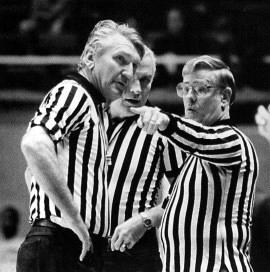 |
Both teams entered the game undefeated and the game itself proved to be a classic, as the two highly touted teams battled back and forth all afternoon. The game was tight early on before Illinois' Doug Altenberger got hot and Illinois held a 33-26 halftime lead.
Kentucky clawed back in the second half to take the lead 42-40 on a Kenny Walker layup before Illinois, went on another scoring spree by Bruce Douglas and Efrem Winters to take a six point lead, 48-42.
Once again Kentucky responded to regain the lead when they started to switch defenses between a 2-3 zone and a man-to-man matchup resulting the Illini going cold for nearly five minutes. But near the end of the game the Illini finally crept back as the clock ticked down with three field goals. With 19 seconds remaining Quinn Richardson hit a jump shot from the foul line to tie the game, 54-all. Kentucky called time out with eight seconds remaining and this gave coach Joe Hall an opportunity to set up a final play for Kentucky to win the game.
As he did in a victory against Indiana a few weeks prior, Hall elected to put the ball in the hands of freshman phenom James Blackmon and let him create a shot. The rest of the players arrayed themselves along the baseline and let Blackmon take his man one-on-one.
Blackmon worked against Illinois guard Bruce Douglas and pulled up for a 15-foot jump shot which fortuitously banked in to secure the win. "He said he went up for a straight shot..He said he had to move the shot around when the defense came out at him. He just went ahead and shot." said fellow freshman teammate Paul Andrews. Joked Coach Hall after the game about Blackmon's shot "He came though...that makes me a smart coach.".
 |
After the game, both coaches praised the referees for their job. "Under the circumstances, I thought they did a super job." noted Hall.
Some players left immediately with their families for Christmas Break but the rest of the team wasn't so lucky. The game was originally scheduled at 2:00 PM and the team planned to fly out of Champaign's small airport by 6:00 PM, but the plane wouldn't start due to the cold and heaters from Chicago O'Hare couldn't arrive either due to the weather. Eventually a bus was chartered to drive the team back to Lexington, with an expected arrival early in the morning.
The road conditions were so poor that bus needed to stop on the side of the highway periodically to allow the coaches to clean the windshield for the driver to see.
[Boxscore] - 1983-84
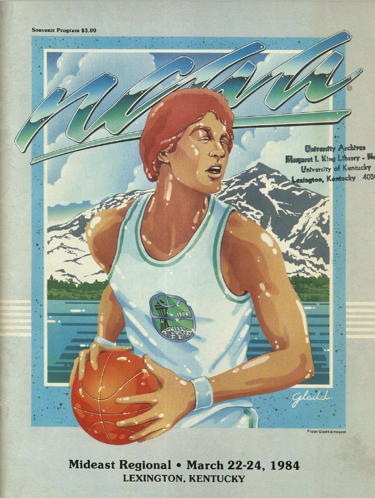 |
The two teams battled again in a tough physical contest. Kentucky led the entire first half until Illinois' Scott Meents hit a shot to tie score at 22-all. But Dicky Beal scored on a jumper just before the half ended to put the Wildcats back on top 24-22.
In the second half, Kentucky once again maintained the lead but never pushed it by more than seven points and most of the time the margin was significantly tighter.
As he did in Champaign, Quinn Richardson hit a last minute shot from the foul line extended to keep the Illini in contention at 52-50. With twenty second left in the game Dicky Beal received the inbounds and drove down the sideline but after crossing the half-court line was trapped by Bruce Douglas and Efrem Winters. Beal pivoted repeatedly to avoid being tied up before Douglas was a called for a foul as he and Beal were falling out of bounds.
Beal hit both free throws to give UK a four point cushion, 54-50. The Illini still had a chance as Richardson missed a shot but got the ball back on a rebounding foul. Kentucky had been fouling to drain time off the clock, but were called for a shooting foul on Doug Altenberger. Altenberger however only hit one of two free throws.
The star of the game was Beal, who scored nine points and dished out six assists, but more importantly controlled the game and came in clutch when it counted. Beal was named the MVP of the Mideast Regional. Melvin Turpin led the Wildcats in scoring with 13 points and Sam Bowie added 11 points and 14 rebounds.
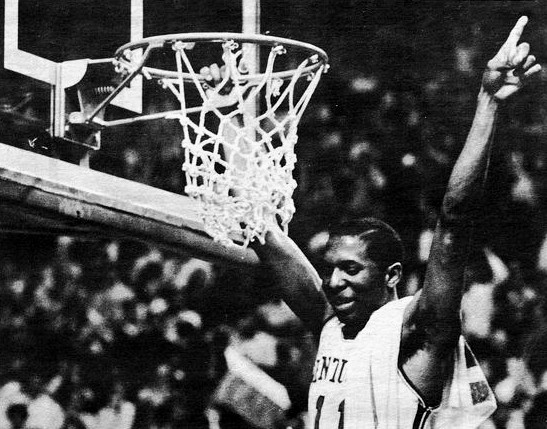 |
For the Illini, Quinn Richardson led with 16 points while Doug Altenberger added 13.
[Boxscore] - 1983-84 - NCAA Tournament
After the game there was immediate reaction to the fact that Kentucky was allowed to play on it's home court for such an important game. Within two years the NCAA instituted a rule that a team could not be placed in the same region where it was hosting a regional. A few years later this was extended to first and second rounds, due to a perceived advantage by the Syracuse Orangement getting to play early round games in the Carrier Dome.
There was also controversy over the foul discrepancy in the second half. Noted Illini Coach Henson: "We had no chance under the conditions presented here...We played good enough ball to win. We thought we played pretty well. With a break here and there, we could have won the trip to Seattle. Until the last five seconds of the game (sic), the fouls called in the second half numbered 11 against us and two against Kentucky." (JPS Note: actually that was the discrepancy with 14 seconds remaining, before UK went on a fouling spree to waste clock.)
Another point of contention with the referees was with respect to the reputed missed travel by Beal late in the game. "At a neutral site, it might have gone our way. I guess it all depends on what kind of referees we have." lamented Illinois center George Montgomery. However a close review of the play in slow motion clearly shows that Beal successfully established and maintained his left pivot foot and was fouled by Douglas (who was actually out of bounds at the time he tied up Beal, if he ever did).
![]()
Please note that the following reference materials were consulted for the above. 1.) Lexington Herald and Lexington Leader 2.) A Winning Tradition by Bert Nelli 3.) A Century of Orange and Blue by Jared Gelfond 4.) The Chicago Tribune 5.) The University of Illinois Media Guide 6.) Big Blue Machine by Russell Rice 7.) Louisville Courier-Journal among others.
Return to Kentucky Rivalries, Illinois Series Results, statistics, teams, opponents, players, coaches, opposing coaches, games or search this site.
Page written by Jon Scott. Please with any corrections or additional information.
Last Updated March 22, 2025